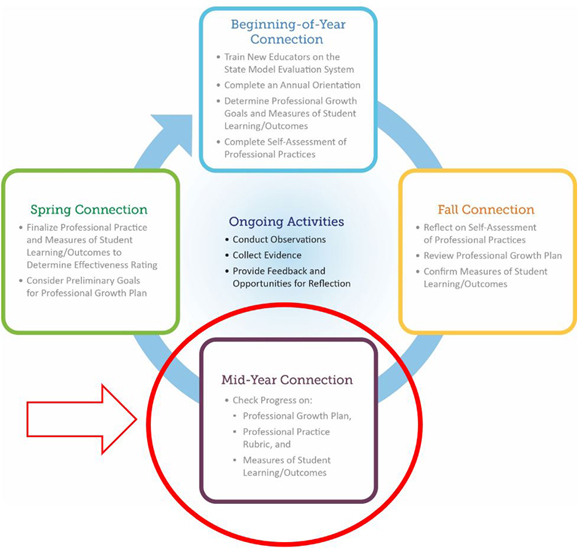CDE will be closed on Friday, July 4, 2025, for the Independence Day holiday.
You are here
Maximizing the Mid-Year Review
The Mid-Year Review
Prior to the beginning of the second semester, the educator being evaluated and the evaluator should review progress to date toward achieving professional goals and measures of student learning/outcomes. Barriers to completing goals and refining existing goals should be discussed as needed. As a result of this review, every educator should have a clear understanding of what needs to be accomplished in order to achieve their performance goals by the end of the year.
The mid-year review may be approached in a variety of ways. This document includes some items LEAs may choose to incorporate as a part of the mid-year review. Please note that each item should be viewed within the context of an LEA and the specific local evaluation process in place for its educators.
At a Glance

Prior to the Mid-Year Review
The Evaluator should make sure the review is scheduled. Both parties should review the Professional Growth Plan (PGP) in preparation for the review. The self-assessment can be reviewed by the person being evaluated and the evaluator if it has been shared. This can be compared to observation data to-date, as well as a preliminary Evaluator Assessment, if the information is available. A review of the MSL/Os may also be helpful to see that everything is on track for the year. Once the review is scheduled, the educator may begin mid-year review form tracking any barriers to achieving goals and identify whether adjustment to goals is necessary.
During the Mid-Year Review
The focus of this meeting is to address barriers toward meeting annual goals and immediate action steps needed to overcome such barriers. If the educator has already identified possible barriers to achieving goals or adjustments are necessary, the review is a great time to discuss possible interventions.
It may also be helpful to bring in evidence on progress toward the MSL/Os for educators, if available. If any measures have been completed (e.g., one measure specifically addresses first semester assessments), evaluators can rate the measure. If additional evidence is required, it can be determined if it should be provided by the evaluator, the person being evaluated, or whether it will come from an outside data source (vendors).
If the evaluator and person being evaluated have the ability to compare the self-assessment to observation data and/or a preliminary Evaluator Assessment, this is also an opportunity for a focused discussion. It may also be a great place to start the conversation of whether additional artifacts and/or targeted observations are required for the final assessment. The person being evaluated may also be invited to suggest opportunities for determining performance on non-observable items.
After the Mid-Year Review
After the mid-year review, it may be necessary to have ongoing check-ins regarding progress toward goals and/or additional revisions to the PGP and/or MSL/Os may be necessary.
If the evaluator has access to real-time reports for the building/district as a whole, there may be opportunity to identify professional development for both individuals and/or groups. These reports may also provide information to identify ways to partner educators with complementary skillsets.
Evaluators should continue adding to the body of evidence for the educator throughout the year. These may come in the form of additional evidence and artifacts or additional observation opportunities for the professional practices. For the MSL/Os, they can continue to be updated as data is available.



Connect With Us





